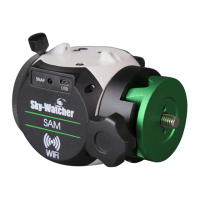Astrophotography and Astro Time-Lapse
Astrophotography
Astrophotography refers to photography of the night me sky. It has
become far more familiar to us due to the incredible images recorded
by the Hubble Space Telescope and shared by NASA with the public
over the past two decades. But astrophotography didn’t start with
the Hubble Space Telescope. In fact, it started more than 100 years
ago and has been done in large part since that me by amateur
astronomers.
With SAM, astrophotography is now something you can do, too. You
won’t be able to produce photographs that have the same image
scale as those taken by the Hubble, but you will be able to make
beauful portraits of constellaons and large regions of the Milkyway
galaxy showing star clouds, star clusters, and light and dark nebulae.
You’ll be able to record me-lapse videos of auroras, and the stages
of a lunar eclipse.
First, however, there are two challenges to overcome that you don’t
encounter in typical, terrestrial types of photography. One is the need
to use long exposures (e.g., greater than 30 seconds) to record dim
night sky objects. The second is the need to have the camera follow
the sky as the exposure is taking place.
The Need For Long Exposures
Unfortunately, you can’t just set your camera to AUTO, aim it at
the night sky and take a picture. The night sky is far too dim for
that to work, and any aempts you make will produce seriously
underexposed results. But, you can overcome this challenge by
selecng BULB mode on your camera and using SAM’s SNAP cable
The MilkyWay Galaxy revealed through a
long exposure astrophoto with precision
tracking.
16

